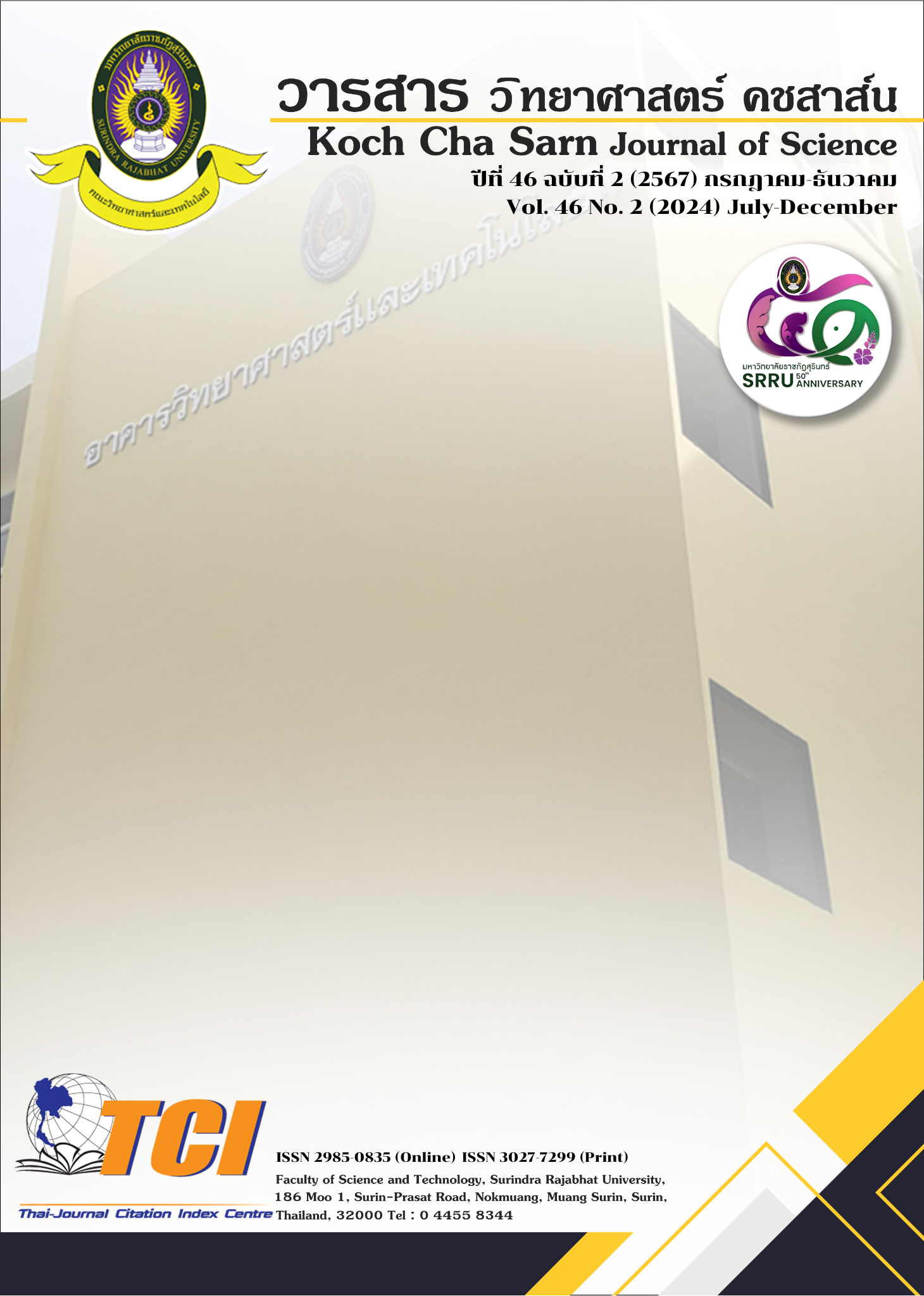Phenolic Compounds, antioxidant and anti-bacterial activities from Markhamia stipulate Seem. Flowers extracts
DOI:
https://doi.org/10.14456/kcsj.2024.7Keywords:
M. stipulate, Antioxidant activity, Antibacterial activity, phytochemical containsAbstract
The edible flower of Markhamia stipulate Seem are widely used in Thai traditional medicine to treat a variety of health issues. The aims of this study were to investigate antioxidant activity and antibacterial of crude extracts from M. stipulate. In the present study, total phenolic compound, antioxidant activities and antibacterial activities of the 50%ethanolic extract from flower of M. stipulate were evaluated. The total phenolic contents was quantified based on the Folin–Ciocalteu method, and the antioxidant activities of the extract were assessed through the DPPH and FRAP assays. The broth dilution method, MIC and MBC were used to evaluate the antibacterial activity of the extract against Staphylococcus aureus, Streptococcus mutans, Bacillus subtilis and Escherichia coli. The results revealed that the total phenolic contents of the extracts was 53.71±0.002 mg of gallic acid equivalent/g of extract. Additionally, the antioxidant activities in terms of IC50 value of the extracts were 43.56±0.044 mg/mL and 38.43±0.013 mg/mL, according to the DPPH and the FRAP assay. Crude extract of M. stipulate flower also demonstrated antibacterial activity against selected bacterial strains, with MIC and MBC values ranging from 1.56 to 200 mg/mL. In summary, the results suggest that flower extract of M. stipulate may serve as valuable sources of bioactive compounds with antioxidant and antibacterial properties.
Downloads
References
Zhang Y-J, Gan R-Y, Li S, Zhou Y, Li A-N, Xu D-P, et al. Antioxidant phytochemicals for the prevention and treatment of chronic diseases. Molecules. 2015;20(12):21138–56. Available from: http://dx.doi.org/10.3390/molecules201219753
Nowak D, Goslinski M, Kłebukowska L. Antioxidant and antimicrobial properties of selected fruit juices. Plant Foods Hum Nutr. 2022;77(3):427–35. Available from: http://dx.doi.org/10.1007/s11130-022-00983-2
Newman DJ, Cragg GM. Natural products as sources of new drugs over the last 25 years. J Nat Prod [Internet]. 2007;70(3):461–77. Available from: http://dx.doi.org/10.1021/np068054v
Abbasi S, Gharaghani S, Benvidi A, Latif A. Identifying the novel natural antioxidants by coupling different feature selection methods with nonlinear regressions and gas chromatography-mass spectroscopy. Microchem J [Internet]. 2018;139:372–9. Available from: http://dx.doi.org/10.1016/j.microc.2018.03.012
Goswami N, Chatterjee S. Assessment of free radical scavenging potential and oxidative DNA damage preventive activity of Trachyspermum ammi L. (carom) and Foeniculum vulgare Mill. (fennel) seed extracts. Biomed Res Int. 2014;2014:582767. Available from: http://dx.doi.org/10.1155/2014/582767
Bardaweel SK, Tawaha KA, Hudaib MM. Antioxidant, antimicrobial and antiproliferative activities of Anthemis palestina essential oil. BMC Complement Altern Med. 2014;14(1):297. Available from: http://dx.doi.org/10.1186/1472-6882-14-297
Yaraksa N. Antioxidant Activity of Markhamia stipulate, Caryota maxima, Amphineurion marginatum Extracts and Cytotoxicity Effect on Human Dermal Fibroblast Cells. RMUTI Journal. 2019 [cited 2024 May 13];12(2):138–48. Available from: https://ph01.tci-thaijo.org/index.php/rmutijo/article/view/212880
Ribeiro DB, Santos Silva G, Dos Santos DR, Castro Costa AR, Braga Ribeiro E, Badea M, et al. Determination of the antioxidant activity of samples of tea and commercial sources of vitamin C, using an enzymatic biosensor. Antioxidants (Basel). 2021;10(2):324. Available from: http://dx.doi.org/10.3390/antiox10020324
Papas AM. Other Antioxidants. In: Antioxidant Status, Diet, Nutrition, and Health. CRC Press; 2019. p. 231–48.
Devi WR, Singh SB, Singh CB. Antioxidant and anti-dermatophytic properties leaf and stem bark of Xylosma longifolium clos. BMC Complement Altern Med. 2013;13(1):155. Available from: http://dx.doi.org/10.1186/1472-6882-13-155
Afsar T, Khan MR, Razak S, Ullah S, Mirza B. Antipyretic, anti-inflammatory and analgesic activity of Acacia hydaspica R. Parker and its phytochemical analysis. BMC Complement Altern Med. 2015;15(1):136. Available from: http://dx.doi.org/10.1186/s12906-015-0658-8
Yaraksa N. Antibacterial activity against some human pathogenic bacteria and anti-inflammatory activity of five Thai medicinal plant extracts. CreSci. 2019 [cited 2024 May 14];11(1):1–10. Available from: https://ph01.tci-thaijo.org/index.php/snru_journal/article/view/130373
Hoque MM, Rattila S, Shishir MA, Bari ML, Inatsu Y, Kawamoto S. Antibacterial activity of ethanol extract of betel leaf (Piper betle L.) against some food borne pathogens. Banglad J Microbiol [Internet]. 2012 [cited 2024 May 14];28(2):58–63. Available from: https://www.banglajol.info/index.php/BJM/article/view/11817
Nie J-Y, Zhang Y, Li R, Jiang Z-T, Wang Y, Tan J, et al. Screening of radical scavenging activity and chemical constituents of the essential oil from star anise by ultra‐fast GC electronic nose coupled with DPPH, OH, and ABTS assays. J Food Process Preserv. 2021;45(1). Available from: http://dx.doi.org/10.1111/jfpp.15022
Kupina S, Fields C, Roman MC, Brunelle SL. Determination of total phenolic content using the folin-C assay: Single-laboratory validation, first action 2017.13. J AOAC Int. 2019;102(1):320–1. Available from: http://dx.doi.org/10.5740/jaoacint.18-0031
Kaisoon O, Siriamornpun S, Weerapreeyakul N, Meeso N. Phenolic compounds and antioxidant activities of edible flowers from Thailand. J Funct Foods. 2011;3(2):88–99. Availablefrom: http://dx.doi.org/10.1016/j.jff.2011.03.002
Phaiboon N, Pulbutr P, Sungthong B, Rattanakiat S. Effects of the ethanolic extracts of guava leaves, licorice roots and cloves on the cariogenic properties of streptococcus mutans. Pharmacogn J. 2019;11(5):1029–36.Availablefrom:http://dx.doi.org/10.5530/pj.2019.11.162
Torrungruang K. Antibacterial activity of mangosteen pericarp extract against cariogenic Streptococcus mutans. Chulalongkorn University Dental Journal. 2007;30(1):1–10. Available from: https://digital.car.chula.ac.th/cudj/vol30/iss1/1/
Mahadlek J, Tuntarawongsa S, Phaechamud T. Antioxidant activity and total phenolic contents of some Thai traditional formulation. Isan J Pharm Sci. 2017;13(1):97–105. Available from: https://he01.tci-thaijo.org/index.php/IJPS/article/view/88553
Balasundram N, Sundram K, Samman S. Phenolic compounds in plants and agri-industrial by-products: Antioxidant activity, occurrence, and potential uses. Food Chem. 2006;99(1):191–203. Available from: http://dx.doi.org/10.1016/j.foodchem.2005.07.042
Boulekbache-Makhlouf L, Slimani S, Madani K. Total phenolic content, antioxidant and antibacterial activities of fruits of Eucalyptus globulus cultivated in Algeria. Ind Crops Prod [Internet]. 2013;41:85–9. Available from: http://dx.doi.org/10.1016/j.indcrop.2012.04.019
Karnwal A. In vitro antibacterial activity of Hibiscus rosa sinensis, Chrysanthemum indicum, and Calendula officinalis flower extracts against Gram negative and Gram positive food poisoning bacteria. Advances in Traditional Medicine. 2022;22(3):607–19. Available from: http://dx.doi.org/10.1007/s13596-021-00562-x
Ibrahim MB, Kaushik N, Sowemimo AA, Odukoya OA. Review of the phytochemical and pharmacological studies of the genus Markhamia. Pharmacogn Rev. 2016;10(19):50–9.Available from: http://dx.doi.org/10.4103/0973-7847.176547






